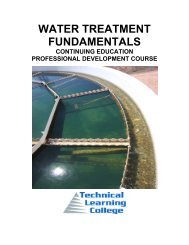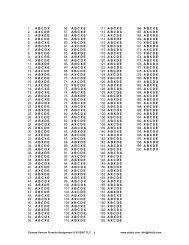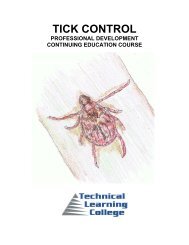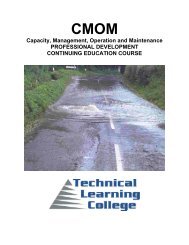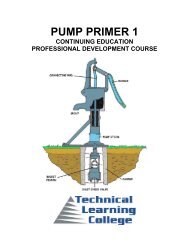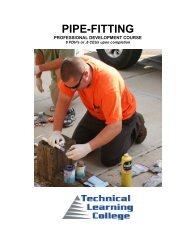- Page 1 and 2: INVASIVE PLANTS IDENTIFICATION AND
- Page 3 and 4: Printing and Saving Instructions Th
- Page 5 and 6: Important Information about this Ma
- Page 7 and 8: Technical Learning College’s Scop
- Page 9: Invasive Plant Identification and C
- Page 13 and 14: TABLE OF CONTENTS Identification Te
- Page 15 and 16: Weed Identification Section A weed
- Page 17 and 18: Weed Classifications Most common we
- Page 19 and 20: (b) Biennials: (1) Bur Clover (2) B
- Page 21 and 22: (4) Spurge (Bull) Nettle (5) Stingi
- Page 23 and 24: Common Weeds Field Bindweed Convolv
- Page 25 and 26: Toadflax is a menace throughout the
- Page 27 and 28: Yellow Alyssum Alyssum alyssoides S
- Page 29 and 30: Oxalis Control 2,4-D combination he
- Page 31 and 32: Quackgrass Elytrigia repens Curly D
- Page 33 and 34: Because of the large number of seed
- Page 35 and 36: Redstem Filaree Erodium cicutarium
- Page 37 and 38: Invasive Plant Species Invasive spe
- Page 39 and 40: Goutweed Aegopodium podagraria L. N
- Page 41 and 42: Garlic Mustard Alliaria petiolata [
- Page 43 and 44: Giant Reed Arundo donax L. NATIVE R
- Page 45 and 46: Musk Thistle Carduus nutans L. NATI
- Page 47 and 48: Asiatic Sand Sedge Carex kobomugi O
- Page 49 and 50: SUGGESTED ALTERNATIVE PLANTS: Asiat
- Page 51 and 52: Invasive Weeds - Yellow Starthistle
- Page 53 and 54: Malta Starthistle Centaurea meliten
- Page 55 and 56: Musk Thistle Seedlings normally eme
- Page 57 and 58: Spotted Knapweed Centaurea bieberst
- Page 59 and 60: Canada Thistle Cirsium arvense (L.)
- Page 61 and 62:
Leafy Spurge Euphorbia esula L. NAT
- Page 63 and 64:
Cogon Grass Imperata cylindrica (L.
- Page 65 and 66:
Chinese lespedeza Lespedeza cuneata
- Page 67 and 68:
Purple Loosestrife Lythrum salicari
- Page 69 and 70:
Japanese Stilt Grass Microstegium v
- Page 71 and 72:
Eurasian Watermilfoil Myriophyllum
- Page 73 and 74:
Burma Reed Neyraudia reynaudiana (K
- Page 75 and 76:
Fountain Grass Pennisetum setaceum
- Page 77 and 78:
Japanese knotweed Polygonum cuspida
- Page 79 and 80:
Lesser Celandine Ranunculus ficaria
- Page 81 and 82:
Common Mullein Verbascum thapsus L.
- Page 83 and 84:
Vine Section Alien Plant Invaders F
- Page 85 and 86:
Porcelainberry Ampelopsis brevipedu
- Page 87 and 88:
Oriental Bittersweet Celastrus orbi
- Page 89 and 90:
Climbing euonymus Euonymus fortunei
- Page 91 and 92:
English Ivy Hedera helix L. NATIVE
- Page 93 and 94:
Japanese honeysuckle Lonicera japon
- Page 95 and 96:
Mile-a-minute weed Polygonum perfol
- Page 97 and 98:
Kudzu Pueraria montana var. lobata
- Page 99 and 100:
Chinese Wisteria Wisteria sinensis
- Page 101 and 102:
Buffalo Gourd, Stinking Gourd, Cala
- Page 103 and 104:
Trees- Alien Plant Invaders Tree-of
- Page 105 and 106:
entire area at one time. Limitation
- Page 107 and 108:
Silk Tree Albizia julibrissin Durz.
- Page 109 and 110:
Australian pine Casuarina equisetif
- Page 111 and 112:
Carrotwood Cupaniopsis anacardioide
- Page 113 and 114:
Princess tree Paulownia tomentosa (
- Page 115 and 116:
White poplar Populus alba L. NATIVE
- Page 117 and 118:
Common buckthorn Rhamnus cathartica
- Page 119 and 120:
Saltcedar Tamarix aphylla, T. chine
- Page 121 and 122:
Reclaiming the Puerco River Article
- Page 123 and 124:
Salt cedar has invaded waterside ec
- Page 125 and 126:
Several communities in the West and
- Page 127 and 128:
Siberian elm Ulmus pumila L. NATIVE
- Page 129 and 130:
Castor Bean Ricinus communis Family
- Page 131 and 132:
Common Grasses and their Scientific
- Page 133 and 134:
Common Broadleaf Weeds with some su
- Page 135 and 136:
Pigweed, tumble Amaranthus albus An
- Page 137 and 138:
Winter and Early Spring Broadleaf P
- Page 139 and 140:
First leaves opposite, later leaves
- Page 141 and 142:
Coneflower Buckwheat Jimsonweed Dat
- Page 143 and 144:
Federal Weed Rule 7 CFR 360.100 Def
- Page 145 and 146:
Cuscuta vetchii Brandegee Cuscuta w
- Page 147 and 148:
California Invasive Plant Section I
- Page 149 and 150:
Exotic Pest Plants of Greatest Ecol
- Page 151 and 152:
CalEPPC Inventory List The Californ
- Page 153 and 154:
List A-1: Most Invasive Wildland Pe
- Page 155 and 156:
List A-2 Most Invasive Wildland Pes
- Page 157 and 158:
List B: Wildland Pest Plants of Les
- Page 159 and 160:
Red Alert: Species with potential t
- Page 161 and 162:
Need More Information Section Latin
- Page 163 and 164:
Piptatherum miliaceum smilo grass A
- Page 165 and 166:
Weed Control Terms The terms listed
- Page 167 and 168:
Weed Control Section Effective weed
- Page 169 and 170:
Mowing is an effective weed control
- Page 171 and 172:
Herbicide Application Section Herbi
- Page 173 and 174:
Weed Control Table #1 Weed Control
- Page 175 and 176:
Crop Herbicide Table # 3 S. No. Fam
- Page 177 and 178:
8. Convolvulaceae (morning-glory fa
- Page 179 and 180:
13. Labiatae (mint family) 14. Legu
- Page 181 and 182:
18. Scrophulariaceae (figwort famil
- Page 183 and 184:
Reducing Weed Control Costs There a
- Page 185 and 186:
Common Herbicide Information Sectio
- Page 187 and 188:
ainbow trout and 28.5 mg/L in Chino
- Page 189 and 190:
Glyphosate Trade and Other Names: T
- Page 191 and 192:
Breakdown in vegetation: Glyphosate
- Page 193 and 194:
2,4-D Trade and Other Names: 2,4-D
- Page 195 and 196:
organic carbon. Under oxygenated co
- Page 197 and 198:
Year-Round Weed Management Strategi
- Page 199 and 200:
Aquatic Toxicology Aquatic toxicolo
- Page 201 and 202:
Habitat Alteration Pesticides can r
- Page 203 and 204:
Federal Pesticide Recordkeeping Req
- Page 205 and 206:
6. Change in provisions for the rel
- Page 207 and 208:
Common Natural Enemies, Pesticide A
- Page 209 and 210:
LADY BEETLES Convergent lady beetle
- Page 211 and 212:
ASSASSIN BUG This aptly-named, vici
- Page 213 and 214:
PREDATORY MITES Adult mites are tin
- Page 215 and 216:
Agricultural Pesticide Section All
- Page 217 and 218:
Mitigating Exposures Mitigating exp
- Page 219 and 220:
Worker Protection Standard Section
- Page 221 and 222:
WPS Requires Notification of Applic
- Page 223 and 224:
WHAT IS THE WORKER PROTECTION STAND
- Page 225 and 226:
DOES THE WORKER PROTECTION STANDARD
- Page 227 and 228:
A person is not a handler if he or
- Page 229 and 230:
How To Comply With the Worker Prote
- Page 231 and 232:
The WPS does not apply when pestici
- Page 233 and 234:
Knowledge of Labeling Information A
- Page 235 and 236:
Exceptions Exceptions to the WPS ar
- Page 237 and 238:
WHICH PESTICIDE USES ARE COVERED? M
- Page 239 and 240:
WHO MUST PROTECT WORKERS AND HANDLE
- Page 241 and 242:
WHAT EMPLOYERS MUST DO FOR BOTH WOR
- Page 243 and 244:
How To Comply With the Worker Prote
- Page 245 and 246:
Under the WPS, you may be both a ha
- Page 247 and 248:
DECONTAMINATION SUPPLIES BASIC RESP
- Page 249 and 250:
Employers of commercial pesticide h
- Page 251 and 252:
Emergency Assistance If there is re
- Page 253 and 254:
FURTHER REQUIREMENTS FOR EMPLOYERS
- Page 255 and 256:
Whenever a small sign is used, ther
- Page 257 and 258:
Employers must provide current and
- Page 259 and 260:
No-contact early-entry workers do n
- Page 261 and 262:
EARLY-ENTRY WORK SITUATIONS BASIC R
- Page 263 and 264:
• waits at least until any inhala
- Page 265 and 266:
GENERAL PROTECTIONS FOR EARLY-ENTRY
- Page 267 and 268:
DECONTAMINATION SUPPLIES FOR EARLY-
- Page 269 and 270:
PERSONAL PROTECTIVE EQUIPMENT FOR E
- Page 271 and 272:
SPECIFIC INSTRUCTIONS FOR HANDLERS
- Page 273 and 274:
Why Rinse Pesticide Containers? Pro
- Page 275 and 276:
How to Triple-Rinse 1. Remove cover
- Page 277 and 278:
PERSONAL PROTECTIVE EQUIPMENT (PPE)
- Page 279 and 280:
Personal Protective Equipment (PPE)
- Page 281 and 282:
EXCEPTIONS TO PPE REQUIREMENTS BASI
- Page 283 and 284:
3. Enclosed cockpits — In an encl
- Page 285 and 286:
Personal Protective Equipment EPA C
- Page 287 and 288:
Interpreting PPE Statements on Pest
- Page 289 and 290:
PROTECTIONS FOR CROP ADVISORS BASIC
- Page 291 and 292:
No PPE for “No Contact” Early E
- Page 293 and 294:
However, while a restricted-entry i
- Page 295 and 296:
APPENDIX A CRITERIA FOR WPS MATERIA
- Page 297 and 298:
• Need for and appropriate use of
- Page 299 and 300:
Definition Section The definitions
- Page 301 and 302:
Adjuvants Activity of Adjuvants Adj
- Page 303 and 304:
Significant pesticide spills must b
- Page 305 and 306:
APPENDIX B SAMPLE FORMS, FACT SHEET
- Page 307 and 308:
INFORMATION ABOUT CLEANING PPE PROT
- Page 309 and 310:
Pesticide Application Record Exampl
- Page 311 and 312:
Instructions This form can be used
- Page 313 and 314:
Master List Pesticide Spill Kit The
- Page 315 and 316:
Personal Protective Equipment Secti
- Page 317 and 318:
Personal Protective Equipment Polic
- Page 319 and 320:
Respiratory Protection Section Gene
- Page 321 and 322:
Different kinds of Air-Supplying Re
- Page 323 and 324:
Overview OSHA requires that supervi
- Page 325 and 326:
Respiratory Protection Program This
- Page 327 and 328:
Program Evaluation Evaluations of t
- Page 329 and 330:
Fit Testing- Hands-on Respirator Tr
- Page 331 and 332:
Respirator Filter & Canister Replac
- Page 333 and 334:
Follow-up Medical Examination The E
- Page 335 and 336:
not limited to, facial scarring, de
- Page 337 and 338:
Cleaning and Disinfecting (See Appe
- Page 339 and 340:
Cylinders used to supply breathing
- Page 341 and 342:
Information Centers The OPPTS Chemi
- Page 343 and 344:
Plant / Animal Abbreviations A - ad
- Page 345 and 346:
Weed and Plant Glossary Abaxial - a
- Page 347 and 348:
Articulate - a. (L. articulatus, jo
- Page 349 and 350:
Capillary - a. (L. capillaris, from
- Page 351 and 352:
Competition - n. (L. competitio, an
- Page 353 and 354:
Diverticulate - a. (L. divertere, t
- Page 355 and 356:
Floccose - a. (L. floccus, a lock o
- Page 357 and 358:
Hyaline - a. (Gr. hyalos, glass) of
- Page 359 and 360:
Ligule - n., hyaline extension of t
- Page 361 and 362:
Oviparous - a. (L. ovum, an egg; pa
- Page 363 and 364:
Polypetalous - a. (Gr. polys, many;
- Page 365 and 366:
Secund - a. (L. secundus, following
- Page 367 and 368:
Subulate - a. (L. subula, an awl) a
- Page 369 and 370:
Verrucose - a (L. verrucosus, full
- Page 371 and 372:
References 40 Code of Federal Regul
- Page 373:
We welcome you to complete the assi



